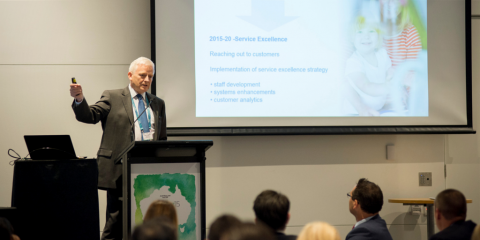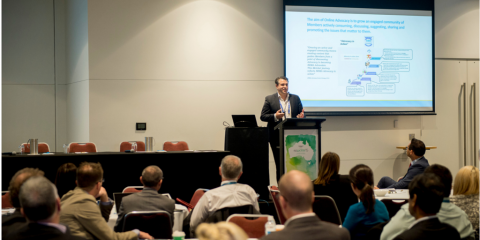Well, not that much as it happens - but putting the CEO of one of the UK's best water utilities together with the Head of Public Affairs at the NRMA and a couple of WSAA's leading best and brightest in customer service and digital strategy led to a stimulating few days of discussion about how we in Australia engage with our customers. Bear with me, the Datsun Sunny will reappear a little later.
I think its fair to say that all of us, certainly Gen X and above who haven’t grown up with the mobile technology now available have struggled to keep abreast of the sheer rate of change in this space. Water utilities have always been good adopters of new technology, particularly so in the digital realm as we operate expensive and sophisticated kit. Note I haven’t talked about customers yet, we’ve always had that internal zen going: ‘so long as my assets are operating well then my customers must be happy’. Wrong! Problems appear on Twitter and Instagram in an instant, issues get rapid grassroots support through Facebook, no one below 30 wears a watch and everyone has grown a smart phone from their fingertips. The scale, complexity and rate of change in this digital age is mind blowing. So, how do we as utilities engage with our customers with these new channels?

Chris Loughlin, CEO of South West Water (@SouthWestWater) was our key note speaker on the back of the recent price review in the UK (PR14 as they affectionately called it) where customers were so impressed with the engagement in developing the business plan that OFWAT gave them ‘enhanced’ status, in other words they didn’t have to go through numerous iterations to get it approved. Their customer engagement be designed to be flexible and dynamic split between understanding customer priorities and presenting options and allowing customers to choose. If customers weren’t happy they went back, and back again if they had to. Focus groups, willingness to pay, language testing and acceptability testing were all part of the process. In the digital space South West Water have developed tools like WaterLive (real time mapping of any issues with the water network), BeachLive (water quality, surf reports for 38 beaches) and were the first to have smartphone apps including mobile payments. The list is extensive. One of the most impressive goals is to have their customer call centres make mostly outbound calls – that is not having customers call with issues, complaints or questions, but proactively providing that sort of information. What’s been the result of this continuous customer engagement? Customer satisfaction has increased by 14% over the past 5 years. This is where the Leyland Mini comes in: imagine, as Chris pointed out picking up his first new car back in the 70s, how would you as a customer feel when the car dealership said: ‘we expect things to go wrong, so when they do, just come back and we’ll fix them one by one’. Imagine putting your products out there in the market place knowing they were not up to scratch, or worse putting the onus on your customer to tell you so?
Hamish Reid from South East Water (@southeastwater) in Melbourne was strongly of the view that we can’t get away from the fundamentals: even as technology is changing at a frightening pace. The seemingly simple things like accessing non-traditional water utility skills in a highly competitive market are presenting changes in the here and now. Specialists who move on quickly from role to role, with remuneration levels to make your eyes water; value of flexibility balanced against setting rigorous specifications for your digital platforms; and balancing innovation and ‘apps’ with the absolute fundamental that you are trying to engage with your customers through a new medium and so building personalised and emotional connections is at the core. It seemed to me after hearing Hamish that focusing on the customer experience – checking, rechecking, measuring and improving is pivotal.
How many utilities have a digital strategy? Not that many I would have guessed, although I’m sure nearly all are thinking about it or have one under development. Anika Johnstone, Manager of Digital Strategy from SA Water (@SAWaterCorp) talked about six critical success factors developing a digital strategy. Backing Hamish’s call that processes must perform I was most impressed by the focus on people, not technology. SA Water actively encouraged staff to use and play the new technology channels – in other words develop internal hype before going external with customers.

Our other guest speaker was Reg Chamberlain from @NRMA, just to stop us water professionals from diving too much into group think. The Datsun Sunny must come in here you say. You’re right, back in my uni days I shared ownership of one of those little beasts for a couple of years with my brother. One rainy May night in Sydney, State of Origin night as it happens, that little Sunny gave up its fight for life, except it was on the Harbour Bridge. I won’t mention the verbal abuse I received, nor who won the game that night but that was the last time I ever called the NRMA. It’s a business that’s had to reinvent itself. But in the advocacy space it has come back with a vengeance using digital channels to harness member support for the state of roads, the right way to use a roundabout (video included) and many other issues. It seems to be all grass roots through Facebook in particular, but very rapidly grows. The numbers of hits and rates of engagement make us in the water industry salivate.
What seems to be a must as we engage our customers in this digital age is not to get wrapped up with the technology: its all about people and after all, water is one of those things people have just a little bit more of a spiritual connection with. Apps, social media, intelligent networks are all amazing digital tools but harnessing the emotional energy of people to effect change through whatever channel is the name of the game.
